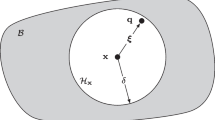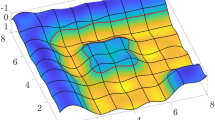Abstract
For hydrocarbon fuels, detailed chemical kinetics typically involve a large number of chemical species and reactions. In a high-fidelity combustion calculation, it is essential, though challenging, to incorporate sufficiently detailed chemical kinetics to enable reliable predictions of thermo-chemical quantities, especially for pollutants such as NO x and CO. In this paper, we review the recent work on efficient implementation of chemistry at Cornell, specifically: the invariant constrained equilibrium-edge pre-image curve dimension-reduction method for the reduced description of reactive flows; the transport-chemistry coupling in the reduced description; the computationally efficient operator-splitting schemes for reactive flows; and, recent developments in the storage/retrieval algorithm in situ adaptive tabulation.
Similar content being viewed by others
References
Poinsot, T., Veynante, D.: Theoretical and Numerical Combustion, 1st edn. R.T. Edwards Inc., Philadelphia (2001)
Pope, S.B.: Turbulent Flows. Cambridge University Press, Cambridge (2000)
Bilger, R.W., Pope, S.B., Bray, K.N.C., Driscoll, J.F.: Paradigms in turbulent combustion research. Proc. Combust. Inst. 30, 21–42 (2005)
Law, C.K.: Combustion Physics. Cambridge University Press, Cambridge (2006)
Peters, N.: Turbulent Combustion. Cambridge University Press, Cambridge (2000)
Tomlin, A.S., Turányi, T., Pilling, M.J.: Mathematical Tools for the Construction, Investigation and Reduction of Combustion Mechanisms. Comprehensive Chemical Kinetics 35: Low-temperature Combustion and Autoignition. Elsevier, Amsterdam (1997)
Warnatz, J., Maas, U., Dibble, R.W.: Combustion: Physical and Chemical Fundamentals, Modeling and Simulation, Experiments, Pollutant Formation, 3rd edn. Springer, Berlin Heidelberg New York (2001)
Cao, R., Pope, S.B.: The influence of chemical mechanisms on PDF calculations of nonpremixed piloted jet flames. Combust. Flame 143, 450–470 (2005)
Cao, R., Wang, H., Pope, S.B.: The effect of mixing models in PDF calculations of piloted jet flames. Proc. Combust. Inst. 31, 1543–1550 (2007)
Wang, H., Pope, S.B.: Comparison of detailed reaction mechanisms in non-premixed combustion. Combust. Flame (2008, submitted)
Hawkes, E.R., Sankaran, R., Sutherland, J.C., Chen, J.H.: Scalar mixing in direct numerical simulations of temporally evolving plane jet flames with skeletal CO/H 2 kinetics. Proc. Combust. Inst. 31, 1633–1640 (2007)
Curran, H.J., Gaffuri, P., Pitz, W.J., Westbrook, C.K.: A comprehensive modeling study of iso-octane oxidation. Combust. Flame 129, 253–280 (2002)
Lu, T., Law, C.K.: A directed relation graph method for mechanism reduction. Proc. Combust. Inst. 30, 1333–1341 (2005)
Pepiot, P., Pitsch, H.: Systematic reduction of large chemical mechanisms. Paper presented at the 4th joint meeting of the U. S. Sections of the Combustion Institute, Philadelphia, PA, 21–23 March 2005
Bodenstein, M., Lind, S.C.: Geschwindigkeit der Bildung des Bromwasserstoffs aus seinen Elementen. Z. Phys. Chem. 57, 168–175 (1906)
Smooke, M.D. (ed.): Reduced Kinetic Mechanisms and Asymptotic Approximations for Methane-Air Flames, vol. 384. Springer, Berlin (1991)
Keck, J.C., Gillespie, D.: Rate-controlled partial equilibrium method for treating reacting gas-mixtures. Combust. Flame 17, 237–241 (1971)
Keck, J.C.: Rate-controlled constrained equilibrium theory of chemical reactions in complex systems. Prog. Energy Combust. Sci. 16, 125–154 (1990)
Lam, S.H.: Using CSP to understand complex chemical kinetics. Combust. Sci. Technol. 89, 375–404 (1993)
Lam, S.H., Goussis, D.A.: The CSP method of simplifying kinetics. Int. J. Chem. Kinet. 26, 461–486 (1994)
Maas, U., Pope, S.B.: Simplifying chemical-kinetics: intrinsic low-dimensional manifolds in composition space. Combust. Flame 88, 239–264 (1992)
Pope, S.B., Mass, U.: Simplifying chemical kinetics: trajectory-generated low-dimensional manifolds. FDA 93-11. Cornell University, Ithaca (1993)
Roussel, M.R., Fraser, S.J.: Global analysis of enzyme inhibition kinetics. J. Phys. Chem. 97, 8316–8327 (1993)
van Oijen, J.A., de Goey, L.P.H.: Modelling of premixed laminar flames using flamelet-generated manifolds. Combust. Sci. Technol. 161, 113–137 (2000)
Bongers, H., van Oijen, J.A., de Goey, L.P.H.: Intrinsic low-dimensional manifold method extended with diffusion. Proc. Combust. Inst. 29, 1371–1378 (2002)
Gorban, A.N., Karlin, I.V.: Method of invariant manifold for chemical kinetics. Chem. Eng. Sci. 58, 4751–4768 (2003)
Singh, S., Powers, J.M., Paolucci, S.: On slow manifolds of chemically reactive systems. J. Chem. Phys. 117, 1482–1496 (2002)
Gear, C.W., Kaper, T.J., Kevrekidis, I.G., Zagaris, A.: Projecting to a slow manifold: singularly perturbed systems and legacy codes. SIAM J. Appl. Dyn. Syst. 4, 711–732 (2005)
Bykov, V., Maas, U.: The extension of the ILDM concept to reaction-diffusion manifolds. Combust. Theory Model. 11, 839–862 (2007)
Ren, Z., Pope, S.B., Vladimirsky, A., Guckenheimer, J.M.: The invariant constrained equilibrium edge preimage curve method for the dimension reduction of chemical kinetics. J. Chem. Phys. 124, Art. No. 114111 (2006)
Chen, J-Y., Kollmann, W., Dibble, R.W.: PDF modelling of turbulent nonpremixed methane jet flames. Combust. Sci. Technol. 64, 315–346 (1989)
Turányi, T.: Parameterization of reaction mechanisms using orthogonal polynomials. Comput. Chem. 18, 45–54 (1994)
Christo, F.C., Masri, A.R., Nebot, E.M.: An integrated PDF/neural network approach for simulating turbulent reacting systems. Proc. Combust. Inst. 26, 43–48 (1996)
Pope, S.B.: Computationally efficient implementation of combustion chemistry using in situ adaptive tabulation. Combust. Theory Model. 1, 41–63 (1997)
Tonse, S.R., Moriary, N.W., Brown, N.J., Frenklach., M.: PRISM: Piecewise Reusable Implementation of Solution Mapping. An economical strategy for chemical kinetics. Isr. J. Chem. 39, 97–106 (1999)
Yang, B., Pope, S.B.: An investigation of the accuracy of manifold methods and splitting schemes in the computational implementation of combustion chemistry. Combust. Flame 112, 16–32 (1998)
Xu, J., Pope, S.B.: PDF calculations of turbulent nonpremixed flames with local extinction. Combust. Flame 123, 281–307 (2000)
Tang, Q., Xu, J., Pope, S.B.: PDF calculations of local extinction and NO production in piloted-jet turbulent methane/air flames. Proc. Combust. Inst. 28, 133–139 (2000)
Lu, L., Ren, Z., Raman, V., Pope, S.B., Pitsch, H.: LES/FDF/ISAT computations of turbulent flames. In: Proceedings of CTR Summer Program 2004, Center For Turbulence Research, pp. 283–294, CTR, December 2004
Lu, L., Ren, Z., Lantz, S.R., Raman, V., Pope, S.B., Pitsch, H.: Investigation of strategies for the parallel implementation of ISAT in LES/FDF/ISAT computations. Paper presented at the 4th joint meeting of the U. S. Sections of the Combustion Institute, Philadelphia, PA, 21–23 March 2005
Singer, M.A., Pope, S.B.: Exploiting ISAT to solve the reaction-diffusion equation. Combust. Theory Model. 8, 361–383 (2004)
Singer, M.A., Pope, S.B., Najm, H.N.: Operator-splitting with ISAT to model reacting flow with detailed chemistry. Combust. Theory Model. 10, 199–217 (2006)
Gordon, R.L., Masri, A.R., Pope, S.B., Goldin, G.M.: A numerical study of auto-ignition in turbulent lifted flames issuing into a vitiated co-flow. Combust. Theory Model. 11, 351–376 (2007)
Gordon, R.L., Masri, A.R., Pope, S.B., Goldin, G.M.: Transport budgets in turbulent lifted flames of methane autoigniting in a vitiated co-flow. Combust. Flame 151, 495–511 (2007)
Schwer, D.A., Lu, P., Green, W.H. Jr.: An adaptive chemistry approach to modeling complex kinetics in reacting flows. Combust. Flame 133, 451–465 (2003)
Ren, Z., Pope, S.B.: Species reconstruction using pre-image curves. Proc. Combust. Inst. 30, 1293–1300 (2005)
Ren, Z., Pope, S.B., Vladimirsky, A., Guckenheimer, J.M.: Application of the ICE-PIC method for the dimension reduction of chemical kinetics coupled with transport. Proc. Combust. Inst. 31, 473–481 (2007)
Ren, Z., Pope, S.B.: Reduced description of complex dynamics in reactive systems. J. Phys. Chem. A 111, 8464–8474 (2007).
Strang, G.: On the construction and comparison of difference schemes. SIAM J. Numer. Anal. 5, 506–517 (1968)
Ren, Z., Pope, S.B.: Second-order splitting schemes for a class of reactive systems. J. Comput. Phys. (2008, submitted)
Davis, M.J., Skodje, R.T.: Geometric investigation of low-dimensional manifolds in systems approaching equilibrium. J. Chem. Phys. 111, 859–874 (1999)
Ren, Z., Pope, S.B.: The use of slow manifolds in reactive flows. Combust. Flame 147, 243–261 (2006)
Kaper, H.G., Kaper, T.J.: Asymptotic analysis of two reduction methods for systems of chemical reactions. Physica D 165, 66–93 (2002)
Goussis, D.A., Valorani, M., Creta, F., Najm, H.N.: Reactive and reactive-diffusive time scales in stiff reaction-diffusion systems. Prog. Comput. Fluid Dyn. 5, 316–326 (2005)
Yannacopoulos, A.N., Tomlin, A.S., Brindley, J., Merkin, J.H., Pilling., M.J.: The use of algebraic sets in the approximation of inertial manifolds and lumping in chemical kinetic systems. Physica D 83, 421–449 (1995)
Maas, U., Pope, S.B.: Implementation of simplified chemical kinetics based on intrinsic low-dimensional manifolds. Proc. Combust. Inst. 24, 103–112 (1992)
Pope, S.B.: Accessed compositions in turbulent reactive flows. Flow Turbul. Combust. 72, 219–243 (2004)
Lam, S.H.: Reduced chemistry-diffusion coupling. Combust. Sci. Tech. 179, 767–786 (2007)
Ren, Z., Pope, S.B.: Transport-chemistry coupling in the reduced description of reactive flows. Combust. Theory Model. 11, 715–739 (2007)
Author information
Authors and Affiliations
Corresponding author
Additional information
The paper is from the 2nd ECCOMAS Thematic Conference on Computational Combustion.
Rights and permissions
About this article
Cite this article
Pope, S.B., Ren, Z. Efficient Implementation of Chemistry in Computational Combustion. Flow Turbulence Combust 82, 437–453 (2009). https://doi.org/10.1007/s10494-008-9145-3
Received:
Accepted:
Published:
Issue Date:
DOI: https://doi.org/10.1007/s10494-008-9145-3




